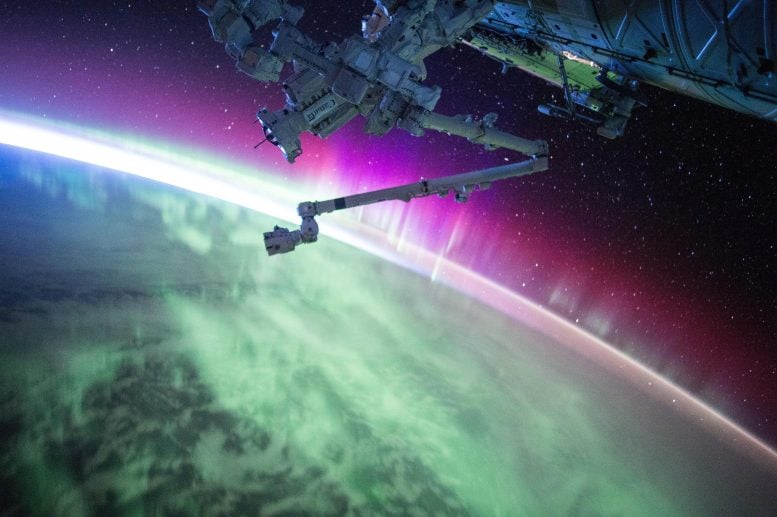
Research on the aurora borealis and magnetically induced currents reveals that the angle of interplanetary shocks relative to the Earth’s magnetic field significantly influences the severity of currents affecting electrical infrastructure. Direct shocks tend to induce stronger currents, which can lead to widespread power outages. Predicting these shocks can help mitigate risks to critical infrastructure.
Scientists have discovered that interplanetary shocks that hit Earth’s magnetic field directly cause more powerful electrical currents at ground level, threatening pipelines and undersea cables.
The northern lights are caused by solar particles hitting the Earth’s magnetic field. But these impacts also cause geomagnetically induced currents at ground level, which can damage electrically conducting infrastructure. Scientists who study these currents to protect critical infrastructure have conducted the first study to compare interplanetary shocks to real-time measurements of geomagnetically induced currents, showing that the angle at which the shocks impact is critical for predicting potential infrastructure damage: Shocks that hit the magnetic field at an angle produce weaker currents.
The impact of interplanetary shocks on infrastructure
The northern lights have inspired myths and omens for millennia, but only now, thanks to modern technology that relies on electricity, are we appreciating their true power. The same forces that cause the northern lights also cause currents that can damage infrastructure that carries electricity, such as pipelines. Frontiers of Astronomy and Space Science demonstrated that the impact angle of interplanetary shocks is critical to the strength of the currents, providing the opportunity to predict dangerous shocks and protect critical infrastructure.
“Both auroras and geomagnetically induced currents are caused by similar space weather factors,” explained Dr. Denny Oliveira of
” data-gt-translate-attributes=”({“attribute”:”data-cmtooltip”, “format”:”html”})” tabindex=”0″ role=”link”>NASA“The aurora is a visual warning that electrical currents in space can generate these geomagnetically induced currents on the ground,” said Goddard Space Flight Center professor and lead author of the paper.
“The auroral region can expand considerably during strong geomagnetic storms,” he added. “Usually its southernmost limit is around latitudes of 70 degrees, but during extreme events it can extend down to 40 degrees or even further, which is certainly what happened during the May 2024 storm, the strongest storm in the last two decades.”
Lights, colors, action
The northern lights are caused by two processes: either particles ejected from the sun reach the Earth’s magnetic field and cause a geomagnetic storm, or interplanetary collisions compress the Earth’s magnetic field. These collisions also generate geomagnetically induced currents, which can damage electrically conducting infrastructure. More powerful interplanetary collisions cause more powerful currents and auroras, but more frequent and less powerful collisions can also cause damage.
“The most severe damage to electrical infrastructure probably occurred in March 1989, following a severe geomagnetic storm: Hydro-Québec’s grid in Canada was paralyzed for nearly nine hours, leaving millions of people without power,” Oliveira said. “But smaller, more frequent events, such as interplanetary collisions, can threaten terrestrial conductors over time. Our work shows that large geoelectric currents occur quite frequently after collisions, and they deserve attention.”
Shocks that hit the Earth head-on, rather than at an angle, are thought to induce stronger geomagnetic currents because they compress the magnetic field more. Scientists have studied how geomagnetic currents are affected by shocks at different angles and at different times of day.
To do this, they used a database of interplanetary shocks and cross-referenced it with records of geomagnetically induced currents from a gas pipeline in Mäntsälä, Finland, which is typically in the auroral region during periods of activity. To calculate the properties of these shocks, such as angle and speed, they used data from the interplanetary magnetic field and the solar wind. The shocks were divided into three groups: highly inclined shocks, moderately inclined shocks, and near-frontal shocks.
Angle of attack
They found that more frontal shocks cause higher peaks in geomagnetically induced currents, both immediately after the shock and during the following substorm. Particularly intense peaks occurred around magnetic midnight, when the North Pole was between the Sun and Mäntsälä. Localized substorms at this time also cause striking auroral brightening.
“Moderate currents occur shortly after the disturbance hits, when Mäntsälä is around dusk local time, while more intense currents occur around midnight local time,” Oliveira said.
Because the angles of these shocks can be predicted up to two hours before impact, this information could allow us to put protections in place for power grids and other vulnerable infrastructure before the strongest, most frontal shocks occur.
“One way that power infrastructure operators could protect their equipment is by managing specific electrical circuits when a shock alert is issued,” Oliveira suggested. “This would prevent geomagnetically induced currents from reducing the equipment’s lifespan.”
However, the scientists did not find strong correlations between the angle of a shock and the time it takes for it to strike and then induce a current. This may be because more recordings of currents at different latitudes are needed to study this aspect.
“The current data were collected only for one particular location, namely the Mäntsälä pipeline network,” Oliveira warned. “Although Mäntsälä is located in a critical location, it does not provide a global picture. In addition, the Mäntsälä data is missing several days in the period studied, which forced us to exclude many events from our shock database. It would be nice if energy companies around the world would make their data available to scientists for study.”
Reference: “First direct observations of the effects of the impact angle of interplanetary shocks on real geomagnetically induced currents: the case of the Finnish gas pipeline system” by Denny M. Oliveira, Eftyhia Zesta and Sergio Vidal-Luengo, May 7, 2024, Frontiers of Astronomy and Space Science.
DOI: 10.3389/fspas.2024.1392697